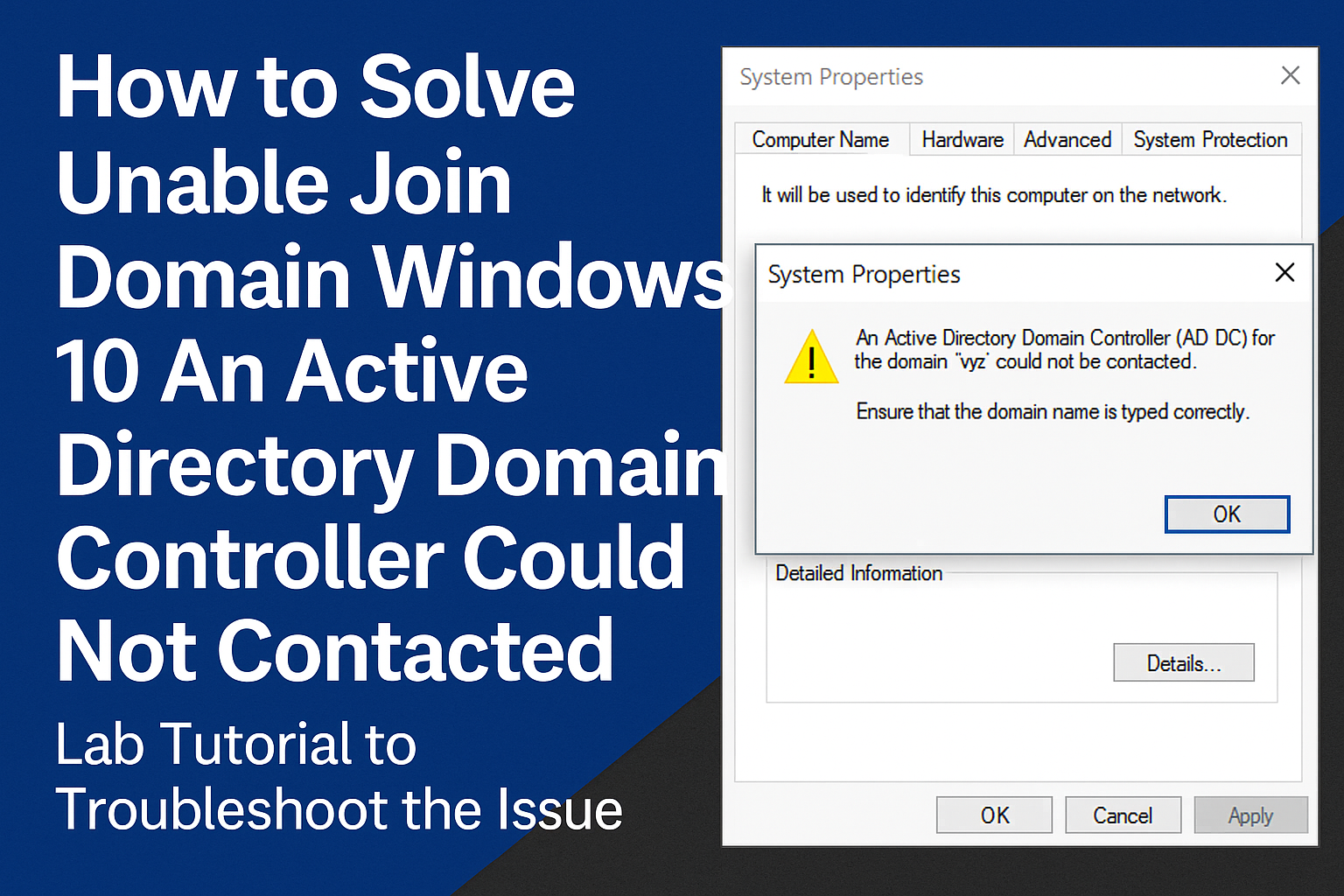Fix Unable to Join Domain Windows 10: An Active Directory Domain Controller Could Not Be Contacted

Joining a Windows 10 machine to a domain is a standard task in business networks. Domains allow centralized user management, policy enforcement, and enhanced security via Active Directory (AD). However, sometimes users encounter a frustrating message
An Active Directory Domain Controller for the domain could not be contacted.”
This error prevents the PC from joining the domain, blocking access to shared resources, group policies, and enterprise services.
In this post, we’ll break down:
- What this error means
- Why it occurs
- Multiple ways to solve it
- A detailed tutorial on the most effective fix
This post is designed for beginners or anyone managing a small to medium-sized network.
💡 What Causes This Error?
When a domain join fails with the message above, here are some common reasons:
🔹 1. Incorrect DNS Settings
Active Directory uses DNS to find and connect to domain controllers. If the client PC is set to use a public DNS server (like 8.8.8.8) instead of the internal AD DNS, it won’t be able to locate the domain. This results in domain join failures. Always configure the client to use the internal DNS server provided by your domain controller.
🔹 2. Network Connectivity Issues
Before a Windows 10 machine can join a domain, it must be able to communicate with the domain controller (DC) over the network. If there’s any disruption physical, logical, or configuration-based the connection attempt will fail, resulting in the error:
“An Active Directory Domain Controller for the domain could not be contacted.”
🔹 3. Time and Date Mismatch
Windows networks that use Active Directory (AD) rely on Kerberos authentication—a protocol that ensures secure identity verification. Kerberos is very sensitive to time differences between the client computer and the domain controller (DC).
Kerberos requires the clocks of all devices on the domain to be within 5 minutes of each other (by default). If your Windows 10 machine’s date or time is significantly ahead or behind, the domain controller rejects the authentication request, thinking it might be a replay attack.
This is a common cause of the “Active Directory Domain Controller could not be contacted” error when trying to join a domain.
🔹 4. Missing or Corrupted SRV Records
What are SRV Records?
Service (SRV) records are special DNS entries that allow a Windows client to locate essential services, such as a domain controller (DC). These records include information like the domain controller’s hostname, port number, priority, and weight.
In an Active Directory domain, SRV records tell client machines where and how to connect to:
Domain controllers
LDAP services (used for authentication)
Kerberos (used for secure sign-on)
Global catalog servers
Why Are SRV Records important?
When you attempt to join a Windows 10 machine to a domain, it doesn’t just look for a simple A (host) record. It performs a DNS query to find SRV records like:
_ldap._tcp.dc._msdcs.yourdomain.com
If this SRV record is missing, corrupted, or incorrect, the client will fail to locate a domain controller — leading to:
An Active Directory Domain Controller for the domain could not be contacted.
🔹 5. Spelling Mistake or Wrong Domain
A typo in the domain name (e.g., vmrcloud.local instead of vmorecloud.com) leads to resolution failure.
nslookup vmorecloud.com
Replace vmorecloud.com with your actual domain name. If it returns the DC’s IP address, your DNS is now configured correctly.
Best Fix: Correcting the DNS Settings
After analyzing different solutions, fixing the DNS configuration is often the most effective and beginner-friendly way to resolve this issue. Most failed domain joins are caused by clients using public DNS (like 8.8.8.8) instead of the domain controller’s DNS.
Let’s now go step-by-step.
Hands-On Tutorial: Fix the Domain Join Error
✅ Step 1: Verify the Domain Controller’s IP
On your Domain Controller. Open Command Prompt and run the following command:
ipconfig
Note down the IPv4 address (e.g., 192.168.119.116). This is the IP address of our domain controller.
Step 2: Set Client DNS to the Domain Controller
On your Windows 10 client:
- Press Windows + R, type ncpa.cpl, press Enter.
- Right-click your active network adapter, click Properties.
- Select Internet Protocol Version 4 (TCP/IPv4) and click Properties.
- Choose Use the following DNS server addresses.
- Set:
- Preferred DNS: 192.168.119.166 (your DC IP)
- Alternate DNS: leave blank or use same IP
- Click OK and close.
Step 3: Verify Domain Resolution
Open Command Prompt:
nslookup yourdomain.com
If it returns your domain controller’s IP, DNS resolution is successful.
Step 4: Join the Domain
- Press
Windows + R, typesysdm.cpl, press Enter. - Click Change next to the computer name.
- Select Domain and enter your domain (e.g., vmorecloud.com).
- Enter domain administrator credentials.
- If successful, you’ll see: Welcome to the domain!
- Reboot your PC when prompted.
Troubleshooting Tips
- Check Firewall: Disable temporarily on both ends.
- Check Time: Ensure Windows client matches server time.
- Use ping yourdomain.com to verify network path.
- Use
nltest /dsgetdc:yourdomain.comfor deeper testing.
Summary
The error An Active Directory Domain Controller Could Not Be Contacted is commonly due to DNS misconfiguration. By pointing your Windows 10 client to the correct DNS (your DC), verifying network connectivity, and ensuring time sync, you’ll be able to join the domain successfully.
This guide simplifies complex AD networking issues into clear steps, even for beginners.



![Windows Server 2025 LTSC [10.0.26100.7171] Version 24H2 4 Windows Server 2025 LTSC [10.0.26100.7171] Version 24H2](https://vmorecloud.com/wp-content/uploads/2025/12/Windows-Server-2025-365x330.jpg)

